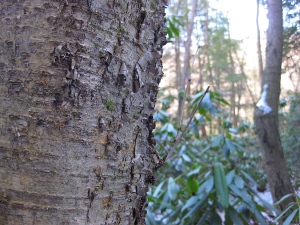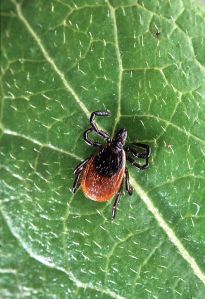 If you’ve ever tapped a maple tree, surely you’ve tasted the fresh sap – unprocessed and unboiled – straight from the tree.
If you’ve ever tapped a maple tree, surely you’ve tasted the fresh sap – unprocessed and unboiled – straight from the tree.
If you have never tapped a maple tree, perhaps you’ve got one of those nice neighbors who generously shares his or her bounty of maple sap. Or perhaps you’ve even purchased and consumed any of the various “maple waters” on the market today.
And if you have no idea what I’m talking about (…tree sap? What the heck is that?), allow me to put this into context.
In late winter/early spring, sap rises in certain trees (i.e. maples and walnuts) due to temperature fluctuations – notably, the freeze/thaw cycle. In other species (i.e. birches), sap flow is governed by root pressure that forms once soil temperatures reach approximately 50° Fahrenheit. This sap contains water and dissolved nutrients (i.e. sugars) that travel up towards the branches, feeding the developing leaves.
If you’re interested in learning which trees produce sap during this season, check out this recent video I filmed. In it, I discuss key identifying characteristics regarding 4 tappable trees, including 2 maples and 2 birches.
Let’s continue the story.
Whenever these trees are wounded during this particular season, sap will flow from inside the trees (sapwood) out through their wounds. Such is the case whenever we tap a tree by placing a hole into its bark. This sap, after collection and prolonged exposure to heat, can be eventually reduced into syrup.
But wait! Before we boil down our precious sap, transforming it into one of nature’s finest sweeteners, we can appreciate this subtly-sweet liquid for all that it is.
In other words, we can drink it. Call me old school, but I like to drink sap unprocessed, consuming whatever I can at the source and storing the rest in containers.
Now, I am familiar with the warning that one ought to boil the sap first, as there’s a possibility that it may harbor pathogenic organisms. If we’re managing a clean operation, however, I believe this fear isn’t always warranted. Still, use your best judgement.
Maple sap, depending on the species, contains varying levels of sugars – notably sucrose. Sap from the sugar maple (Acer saccharum), for example, is approximately 2% sugar.

For the wild food chemists: Sucrose, commonly known as “table sugar” — the predominating sugar in maple sap.
For this reason, maple sap imparts a delicate, sweet taste to the palate, one that becomes extremely concentrated during the sap’s conversion into syrup. While I certainly enjoy maple sap for its delectable late-winter sweetness, I also appreciate its content of vitamins, minerals, enzymes, amino acids, polyphenols, and other health-promoting compounds.
You see, many people are aware that maple syrup confers numerous health benefits, typically dependent to some degree on color. In this article, I’d like to explore the health benefits associated with its often overlooked forebear, a mystifying substance that surely deserves more attention.
Introducing…
The benefits of maple sap
But first, a little history…
While maple syrup is certainly beloved by its largest producer, North America, perhaps no other country utilizes and appreciates maple sap more so than South Korea. It is here where villagers climb the hills every year to collect sap from a maple tree known as “Gorosoe” (Acer mono). This tradition spans almost an entire millennium. Traditionally, villagers would create V-shaped incisions into the trees and channel the sap away with bamboo leaves. Today, the operation is much more modernized, incorporating plastic spouts, tubing, and large holding tanks. Unlike in North America where most sap is turned into maple syrup, Koreans drink the sap with no further processing, or instead use it as cooking water.
Okay, now onto the benefits…
Maple sap improves osteoporosis-like symptoms
“Gorosoe” translates to “the tree that is good for the bones.” Sure, the name sounds promising, but is there any truth to it?
For starters, sap from Acer mono has been shown to contain an impressive mineral analysis, including 16 times the potassium, 37 times the calcium, and 3.9 times the magnesium contents of spring water. All 3 of these minerals are essential for optimal bone health.
To test the bone-supporting effects of maple sap on biological systems, researchers carried out experiments where they put mice on low-calcium diets and supplemented them with various concentrations of A. mono sap (1). Mice who were supplemented with both 50% and 100% maple sap concentrations retained normal serum calcium levels, compared to the lower serum calcium levels of mice fed spring water only and 25% maple sap.
Additionally, in the spring water-fed and 25% maple sap-fed groups, thigh bone density and length were significantly reduced, compared to the mice fed higher concentrations of maple sap. The researchers concluded that 50% sap solution could mitigate osteoporosis-like symptoms induced by a low-calcium diet, and they attributed its mechanism to calcium ion absorption.
Maple sap prevents gastric ulcer formation
Injury to the mucosal lining of the stomach can lead to stomach ulcers. Common causes include infection by the bacteria Helicobacter pylori, long-term use of nonsteroidal anti-inflammatory drugs (NSAIDs) such as aspirin and ibuprofen, and excessive consumption of alcohol. If stomach ulcers are left untreated, they can eventually lead to gastric cancer.
Can something as simple (and tasty) as maple sap prevent these conditions from occurring? Researchers think so.
To test their hypothesis, researchers subjected mice to a procedure intended to cause stress-induced gastric lesions (2). Before the researchers carried out their experiments, however, the mice were pretreated with various supplements:
- One group received L-arginine, an amino acid known to prevent stress-induced gastric mucosal lesions.
- A second group received omeprazole, a prescription drug used to treat stomach ulcers.
- A third group received a freeze-dried powder of Acer mono sap.
- A fourth group (the placebo group) received a single saline administration.
Results were … well … quite impressive!
After being subjected to the stress experiments for 6 hours, the mice in the placebo group displayed abundant lesions, on average 1-2 mm in size. The mice who received L-arginine and omeprazole developed very few lesions. Remarkably, the mice who received maple sap prior to the stress experiments did not present any small or large sized corrosions.
(!!!)
In other words, not only was maple sap effective, it was more effective than L-arginine and omeprazole in protecting against gastric mucosal lesions. The mechanism behind maple sap’s protective effects seems to be related to its ability to significantly lower the mRNA expression of iNOS and nNOS, two enzymes that have been shown to play key roles in the formation of gastric lesions.
Researchers concluded that A. mono sap can be used as an ulcer remedy or for other preventive and nutraceutical purposes.
Maple sap lowers blood pressure
Like Acer mono, Acer okamotoanum is another species of maple found in Korea. Sap concentrations of calcium, potassium, and magnesium are 37, 20, and 3.9 times higher than the levels found in spring water. Just as calcium and potassium are two minerals that function in supporting optimal bone health, they also play a role in regulating blood pressure.

Acer okamotoanum, a species of maple native to Korea. Source: http://www.asianflora.com
To test the blood pressure-lowering effects of A. okamotoanum sap, researchers fed hypertensive rats spring water supplemented with 25%, 50%, or 100% maple sap (3). Compared to the rats fed only commercial spring water, the rats supplemented with all concentrations of maple sap experienced reductions in blood pressure.
Researchers attributed the blood pressure-lowering effect of A. okamotoanum sap to its concentration of potassium ions. As an added benefit, body weight also decreased in the rats fed 50% and 100% maple sap concentrations.
Maple sap prevents hangovers
Originally, the title of this section was “Maple sap facilitates alcohol metabolism,” which is probably the more accurate phrasing of what I’m about to describe. But hey, sometimes you just gotta use sensationalism to capture your audience’s attention! Anyway…
As previously stated, A. okamotoanum sap contains various electrolytes (the dissolved mineral ions of calcium, magnesium, and potassium). Because alcohol consumption has a physiological effect on the absorption, elimination, and serum concentrations of electrolytes and minerals, researchers wanted to see what effect, if any, A. okamotoanum sap had on alcohol metabolism in rats.
Researchers administered concentrations of 25%, 50%, and 100% maple sap to rats, 30 minutes prior to receiving alcohol (4). Compared with the rats fed alcohol without any maple sap, the rats who were pretreated with maple sap demonstrated significant reductions 5 hours later in the blood concentrations of both alcohol and acetaldehyde – a toxic byproduct of alcohol metabolism.
Additionally, mRNA expression of alcohol dehydrogenase (ADH) and aldehyde dehydrogenase (ALDH), two liver enzymes necessary for alcohol metabolism, was significantly increased in the rats pretreated with maple sap (increased is a good thing in this case). The results suggest that, at least in rats, consuming maple sap prior to ingesting alcohol can increase the rate at which alcohol is metabolized in the body. The researchers also concluded that maple sap may reduce oxidative stress associated with alcohol consumption.
Maple sap supports a healthy immune response
Whenever our bodies are exposed to pathogenic microbes, our immune systems heed the call to action. In particular, white blood cells known as neutrophils congregate at the site of infection and engulf (think swallow) the offending microbes. Once the pathogens are engulfed, enzymes within our bodies generate substances known as reactive oxygen species (ROS) that, through oxidation, eliminate the bad guys.
This latter process – of generating reactive oxygen species – is necessary in order to remove pathogens, but it can also inflict damage inside our bodies. Oxidation is an on-going process, but too much of it can be a bad thing. Regulation, therefore, is necessary in order to balance this delicate dance between eliminating pathogens while minimally damaging host tissue. Maple sap (A. okamotoanum) may indeed help.
To test this hypothesis, researchers treated mice, rats, and canines with a compound known to impair the immune system, then administered increasing concentrations of A. okamotoanum sap (5). Results showed that treatment with maple sap stimulated the activity of neutrophils (immune cells) in mice, rat and canines. Additionally, the sap enhanced the last step in this process – the elimination of microbes using ROS.
While this study was performed on animals, the researchers concluded that A. okamotoanum sap may have potential antimicrobial effects for patients with infection.
Maple sap contains antioxidants
As mentioned previously, oxidation is a natural process in the human body that, if left unchecked, can result in conditions such as atherosclerosis, diabetes, and Alzheimer’s disease (just to name a few). Antioxidants combat the process of oxidation, and can be produced internally as well as provided externally through the consumption of antioxidant-rich foods – for example, the sugar maple.
The sugar maple (Acer saccharum), a species native to North America, yields the highest volume and concentration of sap, making it a superior candidate for tapping. Its sugar content is approximately 2.0%.
Antioxidants within the sap of A. saccharum have the ability to scavenge the superoxide radical (6) – a potentially destructive molecule that has been implicated in numerous diseases, including diabetes and cardiovascular disease (7, 8).
Out of 10 compounds analyzed in sugar maple sap for their antioxidant effects, only 3 of these are found in maple syrup from the sugar maple. What this means is that several antioxidant compounds are seemingly lost in the transformation from sap into syrup. Perhaps this is one of many benefits to consuming maple sap in its fresh form.
Summary of health benefits: Sap from various maple trees has been shown to provide support for osteoporosis, prevent gastric ulcer formation, lower blood pressure, mitigate alcoholic hangovers, support a healthy immune system, and offer dietary antioxidants.
Now, I understand that most of the research cited in this article involved animals as test subjects. We – Homo sapiens – are animals, sure, though clearly not of the mouse, rat, nor dog type. Therefore, the academic in me will say that “though certainly promising, we cannot entirely extrapolate these findings to humans.” Very dry, I know. But really, researchers will claim that just because maple sap lowers blood pressure in rats doesn’t mean that it’ll do the same to you and me.
Also, I understand that most of the research on maple sap pertains to species of maple that aren’t native to the continent that produces the most maple syrup. Out of the 6 primary research articles I reviewed, only one used the species of maple nearest and dearest to most American tapping enthusiasts – the sugar maple, Acer saccharum. Therefore, we cannot definitively say that the sap from all species of maple will produce the exact same effects on biological systems.
However, the benefits outlined in this article should not be dismissed solely because animals were the test subjects, or because geographically-irrelevant tree species were used. That’s nonsense. There is no doubt that all maple sap, regardless of species, possesses an array of physiologically-active compounds including vitamins, minerals, polyphenols, and antioxidants that all confer important health benefits.
For example, sap from both the sugar and red maple (A. rubrum) has been shown to contain compounds that demonstrate anti-cancer effects (9). Sap from the sugar maple has also been shown to inhibit nitric oxide formation, a process implicated in numerous diseases (10).
If you ask me, I’d say that all maple sap possesses therapeutic potential, and I certainly wouldn’t limit the benefits to only a handful of species.
Additionally, I feel that not only can one acquire substantial benefits by consuming pure maple sap – straight from the tree, no further processing necessary – but I feel there’s another level of therapy to be gained through the actual process of harvesting the sap oneself. No middle man or woman… just you and the maple tree, joined together in communion by the elixir that imbues life to both it and you.
What do you think? Maple sap for the win? If you’ve never imbibed, I highly encourage you to try it. One sip could change your whole life (sorry, no research to back that up). 🙂
Let’s stay in touch! To receive information from Adam Haritan on wild plant and mushroom identification, please enter your name and email address below. Thank you!
Additionally, don’t forget to check out the Facebook and Instagram pages to learn more about wild food nutrition and identification!
—Adam Haritan
















